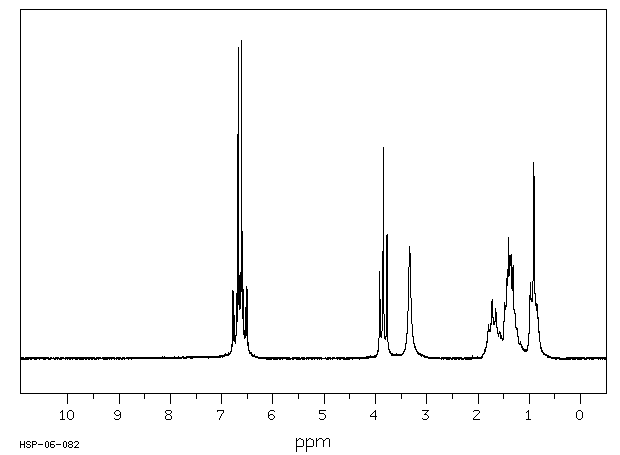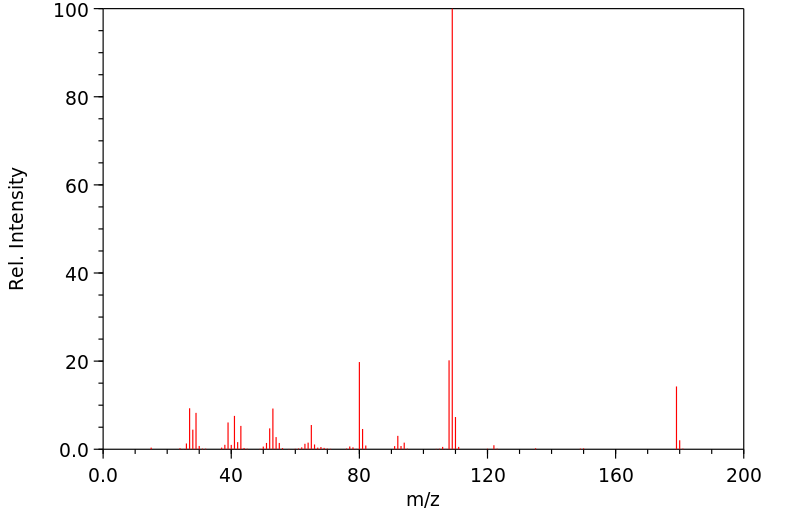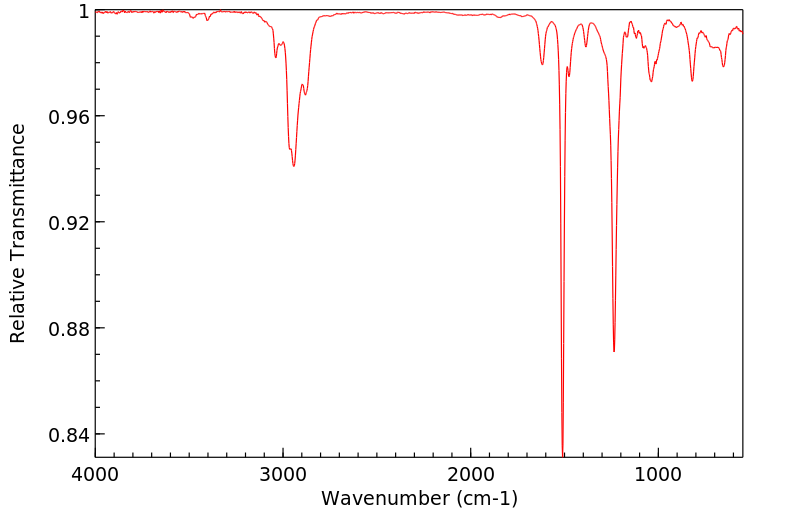4-戊氧基苯胺 | 39905-50-5
中文名称
4-戊氧基苯胺
中文别名
对戊氧基苯胺
英文名称
4-pentyloxyaniline
英文别名
4-pentoxyaniline
CAS
39905-50-5
化学式
C11H17NO
mdl
——
分子量
179.262
InChiKey
QZLNSNIHXKQIIS-UHFFFAOYSA-N
BEILSTEIN
——
EINECS
——
-
物化性质
-
计算性质
-
ADMET
-
安全信息
-
SDS
-
制备方法与用途
-
上下游信息
-
文献信息
-
表征谱图
-
同类化合物
-
相关功能分类
-
相关结构分类
物化性质
-
沸点:311.8°C (rough estimate)
-
密度:0.97 g/mL at 25 °C(lit.)
-
闪点:>230 °F
-
稳定性/保质期:
常规情况下不会分解,也没有任何危险反应。
计算性质
-
辛醇/水分配系数(LogP):3.2
-
重原子数:13
-
可旋转键数:5
-
环数:1.0
-
sp3杂化的碳原子比例:0.45
-
拓扑面积:35.2
-
氢给体数:1
-
氢受体数:2
安全信息
-
危险品标志:Xn
-
海关编码:2922299090
-
储存条件:密封保存,置于阴凉干燥处。
SDS
| Name: | 4-Pentyloxyaniline 99% Material Safety Data Sheet |
| Synonym: | Benzenamine, 4-(Pentyloxy)- |
| CAS: | 39905-50-5 |
Synonym:Benzenamine, 4-(Pentyloxy)-
Section 2 - COMPOSITION, INFORMATION ON INGREDIENTS
| CAS# | Chemical Name | content | EINECS# |
| 39905-50-5 | 4-Pentyloxyaniline | 99% | 254-695-2 |
Risk Phrases: 20/21
Section 3 - HAZARDS IDENTIFICATION
EMERGENCY OVERVIEW
Harmful by inhalation and in contact with skin.The toxicological properties of this material have not been fully investigated.
Potential Health Effects
Eye:
May cause eye irritation.
Skin:
May cause skin irritation.
Ingestion:
May cause irritation of the digestive tract. May cause cardiac disturbances. May cause methemoglobinemia, cyanosis (bluish discoloration of skin due to deficient oxygenation of the blood), convulsions, and death. The toxicological properties of this substance have not been fully investigated. May cause central nervous system depression.
Inhalation:
May cause respiratory tract irritation. May cause methemoglobinemia, cyanosis (bluish discoloration of skin due to deficient oxygenation of the blood), convulsions, tachycardia, dyspnea (labored breathing), and death. The toxicological properties of this substance have not been fully investigated. May cause cardiac abnormalities. Inhalation at high concentrations may cause CNS depression and asphixiation.
Chronic:
No information found.
Section 4 - FIRST AID MEASURES
Eyes: Immediately flush eyes with plenty of water for at least 15 minutes, occasionally lifting the upper and lower eyelids. Get medical aid.
Skin:
Get medical aid. Flush skin with plenty of water for at least 15 minutes while removing contaminated clothing and shoes. Wash clothing before reuse.
Ingestion:
Never give anything by mouth to an unconscious person. Get medical aid. Do NOT induce vomiting. If conscious and alert, rinse mouth and drink 2-4 cupfuls of milk or water.
Inhalation:
Remove from exposure and move to fresh air immediately. If not breathing, give artificial respiration. If breathing is difficult, give oxygen. Get medical aid.
Notes to Physician:
Section 5 - FIRE FIGHTING MEASURES
General Information:
As in any fire, wear a self-contained breathing apparatus in pressure-demand, MSHA/NIOSH (approved or equivalent), and full protective gear. During a fire, irritating and highly toxic gases may be generated by thermal decomposition or combustion. Vapors may be heavier than air. They can spread along the ground and collect in low or confined areas. Containers may explode when heated.
Combustible material; may burn but does not ignite readily. Runoff from fire control or dilution water may cause pollution.
Extinguishing Media:
Use water spray to cool fire-exposed containers. Do NOT get water inside containers. For small fires, use dry chemical, carbon dioxide, or water spray. For large fires, use dry chemical, carbon dioxide, alcohol-resistant foam, or water spray.
Section 6 - ACCIDENTAL RELEASE MEASURES
General Information: Use proper personal protective equipment as indicated in Section 8.
Spills/Leaks:
Absorb spill with inert material (e.g. vermiculite, sand or earth), then place in suitable container. Avoid runoff into storm sewers and ditches which lead to waterways. Clean up spills immediately, observing precautions in the Protective Equipment section. Provide ventilation.
Section 7 - HANDLING and STORAGE
Handling:
Wash thoroughly after handling. Use with adequate ventilation. Avoid contact with eyes, skin, and clothing. Keep container tightly closed.
Avoid ingestion and inhalation.
Storage:
Store in a tightly closed container. Store in a cool, dry, well-ventilated area away from incompatible substances.
Section 8 - EXPOSURE CONTROLS, PERSONAL PROTECTION
Engineering Controls:
Facilities storing or utilizing this material should be equipped with an eyewash facility and a safety shower. Use adequate ventilation to keep airborne concentrations low.
Exposure Limits CAS# 39905-50-5: Personal Protective Equipment Eyes: Wear appropriate protective eyeglasses or chemical safety goggles as described by OSHA's eye and face protection regulations in 29 CFR 1910.133 or European Standard EN166.
Skin:
Wear appropriate protective gloves to prevent skin exposure.
Clothing:
Wear appropriate protective clothing to prevent skin exposure.
Respirators:
Follow the OSHA respirator regulations found in 29 CFR 1910.134 or European Standard EN 149. Use a NIOSH/MSHA or European Standard EN 149 approved respirator if exposure limits are exceeded or if irritation or other symptoms are experienced.
Section 9 - PHYSICAL AND CHEMICAL PROPERTIES
Physical State: Liquid
Color: gold
Odor: Not available.
pH: Not available.
Vapor Pressure: Not available.
Viscosity: Not available.
Boiling Point: Not available.
Freezing/Melting Point: Not available.
Autoignition Temperature: Not applicable.
Flash Point: 109 deg C ( 228.20 deg F)
Explosion Limits, lower: Not available.
Explosion Limits, upper: Not available.
Decomposition Temperature:
Solubility in water:
Specific Gravity/Density: .9700g/cm3
Molecular Formula: C11H17NO
Molecular Weight: 179.26
Section 10 - STABILITY AND REACTIVITY
Chemical Stability:
Stable at room temperature in closed containers under normal storage and handling conditions.
Conditions to Avoid:
Incompatible materials, excess heat, strong oxidants.
Incompatibilities with Other Materials:
Acids, acid chlorides, acid anhydrides, chloroformates, oxidizing agents.
Hazardous Decomposition Products:
Nitrogen oxides, carbon monoxide, irritating and toxic fumes and gases, carbon dioxide, nitrogen.
Hazardous Polymerization: Has not been reported
Section 11 - TOXICOLOGICAL INFORMATION
RTECS#:
CAS# 39905-50-5 unlisted.
LD50/LC50:
Not available.
Carcinogenicity:
4-Pentyloxyaniline - Not listed by ACGIH, IARC, or NTP.
Section 12 - ECOLOGICAL INFORMATION
Section 13 - DISPOSAL CONSIDERATIONS
Dispose of in a manner consistent with federal, state, and local regulations.
Section 14 - TRANSPORT INFORMATION
IATA
Shipping Name: TOXIC LIQUID, ORGANIC, N.O.S.*
Hazard Class: 6.1
UN Number: 2810
Packing Group: III
IMO
Shipping Name: TOXIC LIQUID, ORGANIC, N.O.S.
Hazard Class: 6.1
UN Number: 2810
Packing Group: III
RID/ADR
Shipping Name: TOXIC LIQUID, ORGANIC, N.O.S.
Hazard Class: 6.1
UN Number: 2810
Packing group: III
Section 15 - REGULATORY INFORMATION
European/International Regulations
European Labeling in Accordance with EC Directives
Hazard Symbols: XN
Risk Phrases:
R 20/21 Harmful by inhalation and in contact with
skin.
Safety Phrases:
S 23 Do not inhale gas/fumes/vapour/spray.
WGK (Water Danger/Protection)
CAS# 39905-50-5: No information available.
Canada
CAS# 39905-50-5 is listed on Canada's NDSL List.
CAS# 39905-50-5 is not listed on Canada's Ingredient Disclosure List.
US FEDERAL
TSCA
CAS# 39905-50-5 is listed on the TSCA inventory.
SECTION 16 - ADDITIONAL INFORMATION
N/A
上下游信息
-
上游原料
中文名称 英文名称 CAS号 化学式 分子量 4-硝基苯基戊基醚 4-pentyloxy-nitrobenzene 63469-11-4 C11H15NO3 209.245 —— Acetamide, N-(4-(pentyloxy)phenyl)- 41240-76-0 C13H19NO2 221.299 -
下游产品
中文名称 英文名称 CAS号 化学式 分子量 —— 4-pentyloxyphenyl isocyanate 32223-67-9 C12H15NO2 205.257 —— 1-isothiocyanato-4-pentyloxy-benzene 17608-15-0 C12H15NOS 221.323 —— 1-(4-pentyloxyphenyl)thiourea 92018-23-0 C12H18N2OS 238.354 —— 4,4′-diamino-4″-pentyloxytriphenylamine —— C23H27N3O 361.487 —— p-Methoxybenzylidene-p-n-amyloxyaniline 14921-58-5 C19H23NO2 297.397 —— p-n-Butoxybenzylidene-p-n-amyloxyaniline 14921-61-0 C22H29NO2 339.478 —— N-(p-n-propoxybenzylidene)-p-n-pentyloxyaniline 14921-60-9 C21H27NO2 325.451 —— p-n-Amyloxybenzylidene-p-n-amyloxyaniline 14921-62-1 C23H31NO2 353.505 —— p-Ethoxybenzylidene-p-n-amyloxyaniline 14921-59-6 C20H25NO2 311.424 4-乙炔基苯戊醚 1-ethynyl-4-(pentyloxy)benzene 79887-16-4 C13H16O 188.269 —— p-n-Heptyloxybenzylidene-p-n-amyloxyaniline 14921-64-3 C25H35NO2 381.558 —— p-octyloxy-benzylidene-p'-pentyloxy-aniline 14921-65-4 C26H37NO2 395.585 - 1
- 2
反应信息
-
作为反应物:描述:4-戊氧基苯胺 在 bis-triphenylphosphine-palladium(II) chloride 盐酸 、 sodium hydroxide 、 copper(l) iodide 、 三乙胺 、 potassium iodide 、 sodium nitrite 作用下, 以 甲醇 为溶剂, 生成 4-乙炔基苯戊醚参考文献:名称:向列溶剂中非极性和极性溶质的排序摘要:通过核磁共振 (NMR) 在向列溶剂己基和戊氧基取代的二苯基联乙炔 (DPDA- C6 和 DPDA-OC5,分别)。对非极性 (DPDA-C6) 和极性 (DPDA-OC5) 溶剂以及整个向列型溶剂中标称非极性 (1,4-DCB) 和极性 (1,2-DCB) 溶质的所有四种组合进行测量溶液的温度范围。从这些测量中获得了溶质的二级取向有序参数的温度依赖性,并且溶剂分子的介晶核的相应有序参数独立于碳 13 NMR 测量获得。发现两种溶质的顺序参数分布非常不同,但从一种溶剂到另一种溶剂几乎没有变化。使用 atomist 根据潜在的分子相互作用对结果进行分析和解释...DOI:10.1063/1.1560941
-
作为产物:参考文献:名称:Novel calamitic side-chain metallomesogenic polymers with ferrocene in the backbone: synthesis and properties of thermotropic liquid-crystalline poly(ferrocenylsilanes)摘要:制备出了主链为聚(二茂铁硅烷)、侧链为 4-戊氧基-4′-羟基己氧基偶氮苯或 4-戊氧基-4′-羟基十一烷氧基偶氮苯丙烯酸酯的新型热致金属聚合物;每种材料都呈现出向列介相。DOI:10.1039/a607238k
文献信息
-
Reaction of substituted 1-methylthio-4,5-dihydro[1,2]dithiolo[3,4-c]quinolin iodides with arylamines. Synthesis of novel 1,2-dithiolo[3,4-c]quinolin-1-ylidene(aryl)amines and 10-(arylimino)-7,10-dihydro[1,2]dithiolo[3,4-c]pyrrolo[3,2,1-ij]quinoline-4,5-diones作者:Svetlana M. Medvedeva、Fedor I. Zubkov、Kristina Yu. Yankina、Dmitry G. Grudinin、Khidmet S. ShikhalievDOI:10.24820/ark.5550190.p010.140日期:——series of novel (8-R-7-R’-4,4-dimethyl-4,5-dihydro-1H-[1,2]dithiolo[3,4-c]quinolin-1-ylidene)(4(2)-R”phenyl)amines were synthesized by reaction of 4,4-dimethyl-1-methylthio-4,5-dihydro[1,2]dithiolo[3,4c]quinolin iodides with arylamines in an efficient manner. The Stolle type reaction of the obtained compounds with oxalyl chloride gave 2-R-3-R’-10-[(4(2)-R”-phenyl)imino]-7,7-dimethyl-7,10-dihydro[1,2]dithiolo[3
-
Ethanesulfonamide derivatives申请人:Ortho Pharmaceutical Corporation公开号:US05112866A1公开(公告)日:1992-05-12The synthesis of novel ethanesulfonamide compounds is described. The novel ethanesulfonamide compounds have antisecretory activity and are used in the treatment of peptic ulcer disease. The intermediates used to prepare the ethanesulfonamides are useful in the treatment of osteoporosis and other bone wasting diseases.
-
[EN] SUBSTITUTED PYRROLO[1,2-A]PYRIMIDINES AND THEIR USE IN THE TREATMENT OF MEDICAL DISORDERS<br/>[FR] PYRROLO[1,2-A]PYRIMIDINES SUBSTITUÉES ET LEUR UTILISATION DANS LE TRAITEMENT DE TROUBLES MÉDICAUX申请人:LYSOSOMAL THERAPEUTICS INC公开号:WO2016073891A1公开(公告)日:2016-05-12The invention provides substituted pyrrolo[l,2-a]pyrimi dines and related organic compounds, compositions containing such compounds, medical kits, and methods for using such compounds and compositions to treat medical disorders, e.g., Gaucher disease, Parkinson's disease, Lewy body disease, dementia, or multiple system atrophy, in a patient. Exemplary substituted pyrrolo[1,2-a]pyrimidines compounds described herein include substituted 2,4-dimethyl-N-phenylpyrrolo[l,2-a]pyrimidine-8-carboxamide compounds and variants thereof.
-
A structure–property relationship study of bent-core mesogens with pyridine as the central unit作者:J. M. Marković、N. P. Trišović、T. Tóth-Katona、M. K. Milčić、A. D. Marinković、C. Zhang、A. J. Jákli、K. Fodor-CsorbaDOI:10.1039/c3nj01430d日期:——Three series of bent-core mesogens having pyridine as the central unit have been synthesized and characterized. A series of 2,6-diaminopyridine derivatives capable of forming inter- and intramolecular hydrogen bonds exhibit very high melting points. A decrease in the polarity of the central part of the bent-core obtained by replacing the amide with ester linkages results in derivatives with lower melting
-
Development of LM98, a Small‐Molecule TEAD Inhibitor Derived from Flufenamic Acid作者:Léa Mélin、Shuay Abdullayev、Ahmed Fnaiche、Victoria Vu、Narjara González Suárez、Hong Zeng、Magdalena M. Szewczyk、Fengling Li、Guillermo Senisterra、Abdellah Allali‐Hassani、Irene Chau、Aiping Dong、Simon Woo、Borhane Annabi、Levon Halabelian、Steven R. LaPlante、Masoud Vedadi、Dalia Barsyte‐Lovejoy、Vijayaratnam Santhakumar、Alexandre GagnonDOI:10.1002/cmdc.202100432日期:2021.10.6demonstrating the value of this transcription factor for the development of novel anti-cancer therapies. We report herein the design, synthesis and biological evaluation of LM98, a flufenamic acid analogue. LM98 shows strong affinity to TEAD, inhibits its autopalmitoylation and reduces the YAP-TEAD transcriptional activity. Binding of LM98 to TEAD was supported by 19F-NMR studies while co-crystallizationYAP-TEAD 转录复合物负责调节癌细胞生长和增殖的基因的表达。由于 TEAD 的过表达导致 Hippo 通路的失调已在多种癌症中得到报道。TEAD 的抑制抑制了相关基因的表达,证明了这种转录因子对于开发新型抗癌疗法的价值。我们在此报告了氟灭酸类似物 LM98 的设计、合成和生物学评价。LM98 对 TEAD 显示出很强的亲和力,抑制其自棕榈酰化并降低 YAP-TEAD 转录活性。19支持 LM98 与 TEAD 的结合F-NMR 研究同时共结晶实验证实 LM98 锚定在 TEAD 的棕榈酸袋内。LM98 降低CTGF和Cyr61的表达,抑制 MDA-MB-231 乳腺癌细胞迁移并在细胞分裂期间将细胞周期阻滞在 S 期。
表征谱图
-
氢谱1HNMR
-
质谱MS
-
碳谱13CNMR
-
红外IR
-
拉曼Raman
-
峰位数据
-
峰位匹配
-
表征信息
同类化合物
(R)-3-(叔丁基)-4-(2,6-二异丙氧基苯基)-2,3-二氢苯并[d][1,3]氧杂磷杂环戊烯
(2S,3R)-3-(叔丁基)-2-(二叔丁基膦基)-4-甲氧基-2,3-二氢苯并[d][1,3]氧杂磷杂戊环
(2S,2''S,3S,3''S)-3,3''-二叔丁基-4,4''-二甲氧基-2,2'',3,3''-四氢-2,2''-联苯并[d][1,3]氧杂磷杂戊环
(2R,2''R,3R,3''R)-3,3''-二叔丁基-4,4''-二甲氧基-2,2'',3,3''-四氢-2,2''-联苯并[d][1,3]氧杂磷杂戊环
(2-氟-3-异丙氧基苯基)三氟硼酸钾
(+)-6,6'-{[(1R,3R)-1,3-二甲基-1,3基]双(氧)}双[4,8-双(叔丁基)-2,10-二甲氧基-丙二醇
麦角甾烷-6-酮,2,3,22,23-四羟基-,(2a,3a,5a,22S,23S)-
鲁前列醇
顺式6-(对甲氧基苯基)-5-己烯酸
顺式-铂戊脒碘化物
顺式-四氢-2-苯氧基-N,N,N-三甲基-2H-吡喃-3-铵碘化物
顺式-4-甲氧基苯基1-丙烯基醚
顺式-2,4,5-三甲氧基-1-丙烯基苯
顺式-1,3-二甲基-4-苯基-2-氮杂环丁酮
非那西丁杂质7
非那西丁杂质3
非那西丁杂质22
非那西丁杂质18
非那卡因
非布司他杂质37
非布司他杂质30
非布丙醇
雷诺嗪
阿达洛尔
阿达洛尔
阿莫噁酮
阿莫兰特
阿维西利
阿索卡诺
阿米维林
阿立酮
阿曲汀中间体3
阿普洛尔
阿普斯特杂质67
阿普斯特中间体
阿普斯特中间体
阿托西汀EP杂质A
阿托莫西汀杂质24
阿托莫西汀杂质10
阿托莫西汀EP杂质C
阿尼扎芬
阿利克仑中间体3
间苯胺氢氟乙酰氯
间苯二酚二缩水甘油醚
间苯二酚二异丙醇醚
间苯二酚二(2-羟乙基)醚
间苄氧基苯乙醇
间甲苯氧基乙酸肼
间甲苯氧基乙腈
间甲苯异氰酸酯










